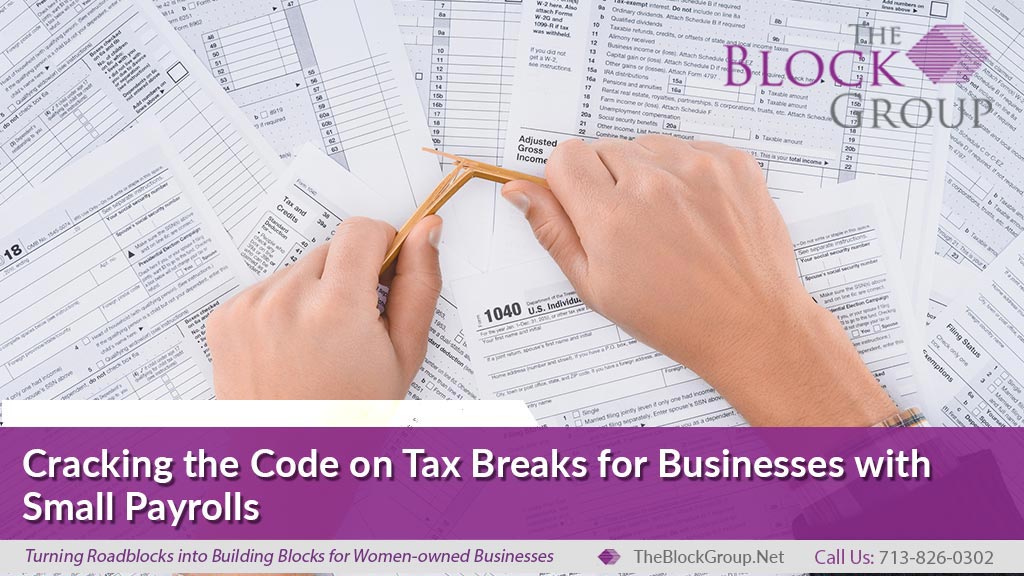
Cracking the Code on Tax Breaks for Businesses with Small Payrolls
Some federal tax breaks depend on being small. Small, in this case, means the number of employees you have. If your business grows, you may think about adding employees. But consider the impact this will have on your access to certain small business tax breaks.
Credit for Starting a Retirement Plan
This amounts to a credit of 50% of expenses up to $1,000 ($500 credit limit) for starting a qualified retirement plan. This might include a 401(k) for your staff. You can claim this credit for three years. And you can even elect to have the year preceding the start of the plan as the first credit year. But the credit applies only if you have no more than 100 employees. And they must have received at least $5,000 in compensation from the business in the preceding year.
At least one employee must participate. And this can’t include someone who is highly-compensated like an employee who is not an owner or owner’s spouse. You can’t claim the credit if during the three tax years preceding the first credit year, you established or maintained a qualified employer plan. This would include any plan to which contributions were made. It would also include plans where benefits were accrued. And it would include any plan for substantially the same employees as are in the new qualified employer plan.
You can claim the credit on Form 8881, Credit for Small Employer Pension Plan Startup Costs.
Note: There is a bi-partisan measure currently pending in Congress that would create new incentives for small businesses with respect to retirement plans. The Setting Every Community Up for Retirement Enhancement (SECURE) Act (H.R. 1994) would increase the potential tax credit for setting up a retirement plan and create a credit for auto-enrollment option in a qualified retirement plan. Watch for developments later this year.
Disabled Access Credit
This is a tax credit of 50% of costs over $250 but not over $10,250 to make your premises accessible or to provide adaptive services. The credit applies only if you have no more than 30 full-time employees during the preceding year or had gross income not exceeding $1 million in the previous year. An employee is considered full-time if employed at least 30 hours per week for 20 or more calendar weeks in the tax year. The credit is figured on Form 8826, Disabled Access Credit.
Small Employer Health Insurance Credit
This is a tax credit of up to 50% of the premiums you pay for your employees. It applies only if you have no more than 25 full-time and full-time equivalent (FTE) employees and their average annual wages are below a threshold amount. The calculation of employees for this credit is complicated. You do not include a sole proprietor, partner, LLC member, more-than-2% S corporation shareholder, owner of more than 5% of the business, or a family member of any of these individuals. And do not count seasonal employees who work 120 or fewer days per year. But do count 30 hours per week by other workers as amounting to one FTE. Exclude from the calculation any hours that exceed 2,080 in the year. So, in effect, only 40 hours per week are counted for any employee.
The credit is claimed on Form 8941, Credit for Small Employer Health Insurance Premiums.
Other Tax Breaks for Small Employers
- Savings Incentive Match Plans for Employees (SIMPLE) Plans. These retirement plans are limited to businesses with 100 or fewer employees who received at least $5,000 in the preceding year.
- Simple cafeteria plans. These are plans offering employees a menu of fringe benefits. It can only be used for businesses with 100 or fewer employees on business days during either of the 2 preceding years.
Other Tax Rules Based on the Number of Employees
- Centralized partnership regime. Partnerships with 100 or fewer partners can elect out of the regime in which the IRS audits the partnership rather than individual partners.
- Exemption from reporting health coverage on employees’ W-2s. If you have fewer than 250 W-2s for the previous year, you aren’t required to report employee health coverage on their W-2s (regardless of who pays for the coverage). However, you can choose to do so.
- Recovery of legal fees from the government. If you have prevailed against an IRS challenge that was not substantially justified, you can recover your legal fees, but only if there are fewer than 500 employees at the time the action was filed and the net worth was below $7 million at the time the action was filed.
Final Thought
Review your eligibility for any of these tax rules with your CPA or other tax advisor.
Source: Smallbiztrends
Patty Block, President and Founder of The Block Group, established her company to advocate for women-owned businesses, helping them position their companies for strategic growth. From improving cash flow…. to increasing staff productivity…. to scaling for growth, these periods of transition — and so many more — provide both challenges and opportunities. Managed effectively, change can become a productive force for growth. The Block Group harnesses that potential, turning roadblocks into building blocks for women-owned businesses.

Coach for Women Business Entrepreneur in Denver Colorado
Business consulting for women entrepreneurs in Denver Colorado, Advice for women entrepreneurs, Business Coach in Denver Colorado, Growth strategies for small business, Business coaching for women, Growth for women-owned businesses, Denver Colorado business coaching, Financial strategies for small business, Small business consulting in Denver Colorado, Business management consultant, Business, Consulting, Women, Entrepreneurs, Denver Colorado, Coach, Growth, Strategies, Coaching, Owned, Owner, Financial, Consulting, Management.




